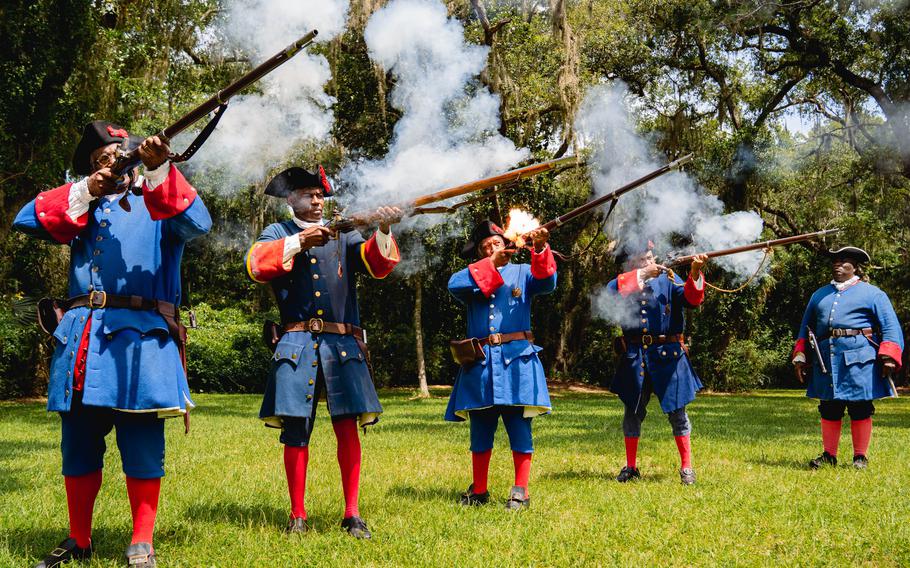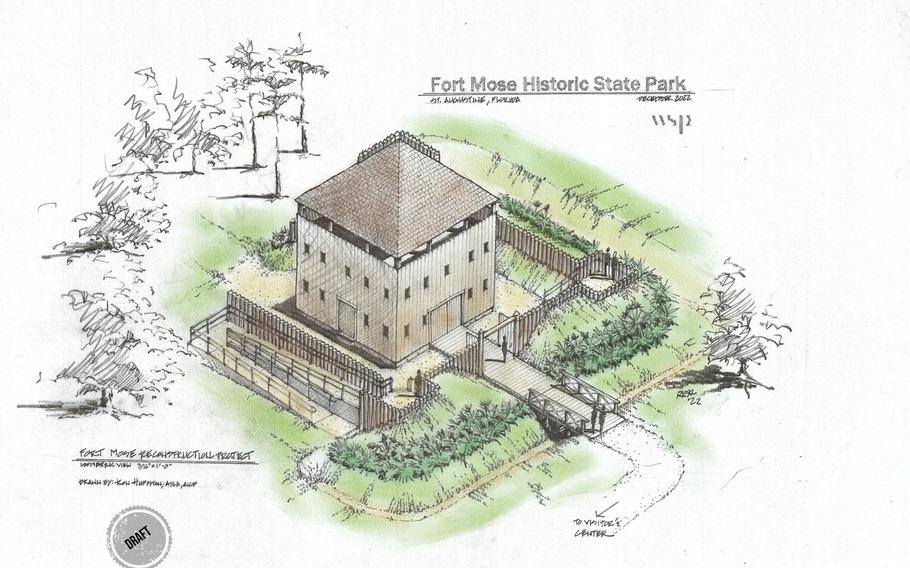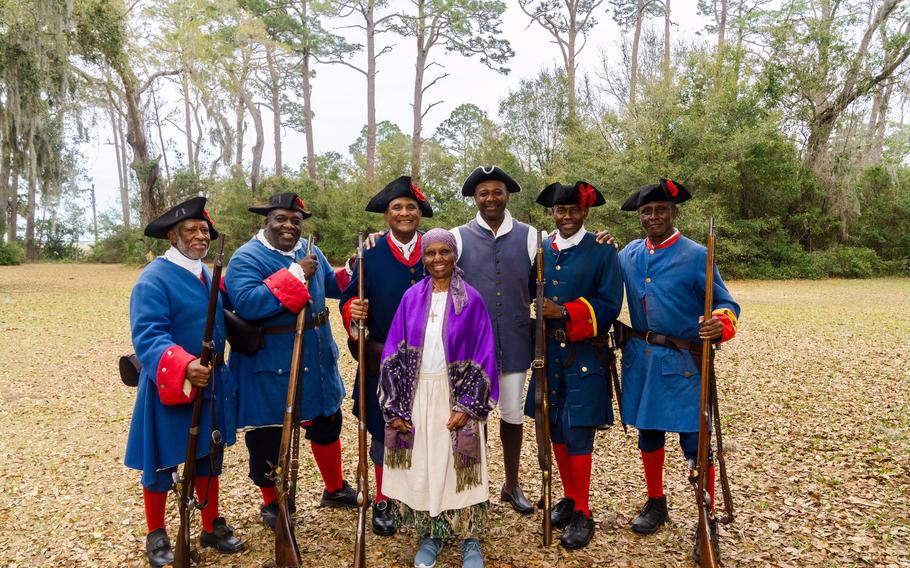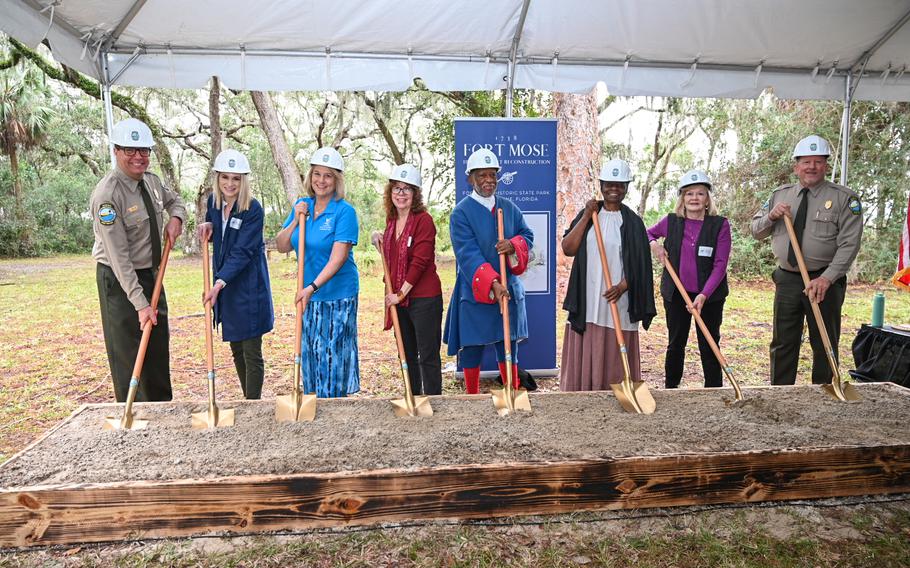
A historical reenactment of the Fort Mose militia in 2021. (Florida State Parks)
When visitors arrive at Fort Mose Historic State Park in St. Augustine, on Florida’s Atlantic coast, it’s common for them to look around and ask, “Where’s the fort?” There isn’t much on the 40-acre grounds except a small museum and a boardwalk leading to a salt marsh. The fort’s remains are buried out there, under earth and water.
But soon, a life-size reproduction of Fort Mose will help tell its story as the first legally sanctioned free African settlement in what is now the United States. An early iteration of the Underground Railroad in the 17th and 18th centuries brought enslaved people from English plantations in the Carolinas down to freedom at Fort Mose, which was controlled by Spanish settlers.
Fort Mose was rediscovered from obscurity in the 1980s. “Nobody knew about it,” said Kathy Deagan, a retired University of Florida archaeologist.
Back when Deagan began full-time field work at Fort Mose in 1986, she could reach the site via a challenging walk through the marsh. “Sometimes the water was up to our knees, and sometimes just plain mud,” she said.
Today, archaeologists must take a boat to the site. The landscape has changed significantly over the years, due to rising sea levels, coastal erosion and dredge-and-fill work.
When archaeologists visit Fort Mose, they are actually visiting a second version of the fort, which was built in 1752 after the first was destroyed by English attackers in 1740. The reproduction is intended to be a recreation of the first fort, of which there is no archaeological evidence, apart from a NASA image from space that shows different light reflectivity suggesting a possible fort moat, said Deagan. However, historians can refer to other Spanish forts of the time period, military protocols, and records about food, clothing, religion and recreation.
The new fort is projected to be completed by the end of 2024 and will sit on solid ground near the museum.

A rendering of the Fort Mose reconstruction. (Florida State Parks Foundation)
The story of Fort Mose goes back to colonial conflicts between Spain and England. St. Augustine, established in 1565, was the first permanent Spanish settlement in what is now the United States, and Jamestown, established in 1607, was the first permanent English settlement. In the decades that followed, word spread among enslaved people at English plantations in the Carolinas — where rice and indigo were staple crops — that there might be a better life for those able to make the dangerous journey down to Florida, often aided by Indigenous people.
The first freedom seekers arrived in St. Augustine in 1687: eight men, two women and a nursing child traveling by dugout canoe. In 1738, the Spanish governor of Florida chartered the settlement of Gracia Real de Santa Teresa de Mose, or Fort Mose, and offered freedom to those willing to pledge allegiance to the king of Spain and convert to Catholicism.
Spanish settlers enslaved Black and Indigenous people, but they also offered a path out of slavery, said Jane Landers, a historian of Fort Mose and a professor at Vanderbilt University. For centuries, there were free Black people in Spain, and Spanish settlers brought this possibility across the ocean, unlike English settlers, who instituted a permanent, race-based system of slavery. About 10 percent of St. Augustine’s population consisted of free and enslaved African people, many of whom came from West Africa.
After Fort Mose had drawn an estimated 100 African people — enough to threaten the English plantation economy to the north — the English responded by attacking St. Augustine in 1740. They were defeated by allied Spanish, Indigenous and Black forces. However, the fort was destroyed, forcing its residents to move into town until it was rebuilt in 1752. The English returned and took control of St. Augustine in 1763, and most of the Spanish-loyal inhabitants of the town and the fort fled to Cuba. By 1812, the fort was abandoned, and in the 1880s, Henry Flagler, a co-founder of Standard Oil, removed a significant amount of soil from the fort’s environs to build a resort nearby.
Starting in the 1980s, archaeologists uncovered the fort’s moat, clay-covered earth walls, and interior wooden buildings. They found artifacts including gun flints, flattened bullets, metal buckles, ceramics, glass bottles, burned seeds and bones from food sources.

Members of the Fort Mose Historical Society earlier this year. (George McKenzie Jr.)
Landers said she has no concerns about historical interpretation when it comes to constructing the new fort. Research on Fort Mose has been happening for a long time, and “the community adopted it,” she said.
The story of Fort Mose is a story of the African diaspora, Deagan said; now the task is making it known. “The story needs to be brought to people, and then they become really amazed,” she said.
“One thing that’s enthusiasm-generating is that this is the history of Florida, and people are getting to understand that Florida settlements were older than the New England ones and the Virginia ones, older than the 13 colonies,” said Chip Storey, a historian and Fort Mose Historical Society board member.
Fort Mose was designated a National Historic Landmark in 1994, and for many years the society wanted to build a new fort, but it wasn’t until 2022 that a major grant from the Florida African American Cultural and Historical Grants Program accelerated the effort. About $3 million has been raised in total, said Julia Woodward, CEO of the Florida State Parks Foundation.
This kind of project is unusual, said Woodward. “This isn’t just a visitor’s center,” she said. “You’re actually bringing history to life.”
Fort Mose is frequented by school groups, and Florida revised its Black history curriculum last year in a way that could affect how students learn about the settlement. The state has adopted a controversial standard to teach students that enslaved people developed skills that could be applied for their personal benefit; blocked an Advanced Placement course in African American studies; and banned the teaching of critical race theory, which suggests, among other things, that racism is systemic. But the new state academic standards require lessons on the history of Fort Mose, and many Florida students visit the park in fourth grade.
“Regardless of what you hear on the media or in the news, there’s going to be a way to tell the story,” said Thomas Jackson, a founding board member of the Fort Mose Historical Society. That story has resonated with many people, both in and out of academia.
“It really developed a community that crossed class and race lines, and people in St. Augustine came together in a way that had never really happened before, to form the Fort Mose Historical Society,” said Deagan. “We couldn’t keep our heads in the ivory tower on this,” she said. “People were too interested.”
While local support for Fort Mose is strong, Woodward thinks it’s underappreciated elsewhere. “How is this not a National Park, because of how historically significant it is?” she said.
“Fort Mose is not in the Smithsonian right now,” said Woodward, referring to the National Museum of African American History and Culture in Washington, D.C. A representative from the museum confirmed that it does not have an exhibit that mentions Fort Mose specifically. “That’s a huge miss,” said Woodward.

The groundbreaking ceremony for the reconstruction of Fort Mose on Jan. 19 in St. Augustine, Fla. Jane Landers, a Vanderbilt University professor and historian of Fort Mose, is fourth from left; Kathy Deagan, retired University of Florida archaeology professor, is second from right. (Roz Zekavat/Florida State Parks Foundation)